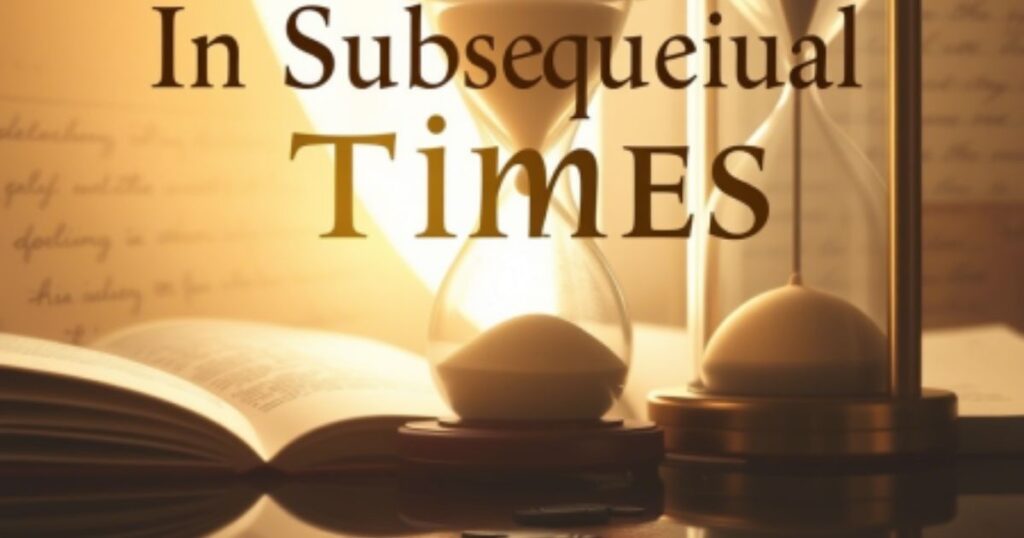Time moves forward, and so does the way we tell stories. In writing, it’s important to show when something happened and what came after. That’s where phrases like since then help us a lot. They show the change from one moment to another and help readers follow the timeline easily. Many writers since then use it to link past events to present outcomes, especially in storytelling, history, and personal experiences.
Using since then makes it easier to describe what happened after a major decision, event, or shift in life. But repeating the same phrase over and over can make your writing sound dull. That’s why having other options is so useful. With the right words, you can make your message clearer and more engaging. In this article, you’ll learn better ways to express time and progress. Knowing different phrases adds variety and depth to your writing in a simple, natural way.
Main Points
- “Since then” helps show a clear connection between past events and what followed after.
- Using synonyms for “since then” adds variety and keeps writing smooth and interesting.
- “After that” shows a clear shift in the timeline after an important moment.
- “Subsequently” connects events and highlights the cause-and-effect between them.
- “Following that” focuses on what happened immediately after a certain event.
- “Thereafter” is useful for showing long-term outcomes or changes.
- “From that time” marks a new phase that began after a specific moment.
- “Later on” shows events or changes that happened at some point after the original action.
- “In the aftermath” focuses on emotional, social, or physical results of a major event.
- “From then on” and “since that moment” both express ongoing change or transformation over time.
After That

The phrase “after that” is very common. It’s simple, and people use it all the time in everyday speech and writing. When something important happens, and something else happens next, we say “after that.” For example: “I finished school. After that, I got a job.” It clearly shows a sequence of events. It connects one thing to the next and helps the listener or reader follow the timeline. It’s like turning the page in a book,you know something new is coming.
This phrase works well in stories and also when explaining your life or work history. It’s a great tool for telling someone about your milestones, your decisions, or how your life has unfolded over time. Whether you’re writing a school essay or sharing a story with a friend, “after that” is a key way to show progression, change, and impact.
Subsequently
The word “subsequently” is more formal than “after that,” but it means the same thing. You use it when you want to sound a bit more serious or professional. For example: “He studied law. Subsequently, he became a judge.” It tells us that one thing led to another, showing a relationship between two actions or decisions. This word helps us understand how outcomes happen and how changes come about.
Using “subsequently” in writing shows that you are thinking carefully about how things connect. It helps you explain events in the correct chronological order, with clarity. You can also use it in emails, reports, or school papers. It’s a strong word that adds coherence and helps guide the reader through your thoughts or story.
Following That
When you want to explain what happened next in a story or situation, you can use the phrase “following that.” It’s a soft and smooth way to show that one thing came after another. For example: “She moved to a new city. Following that, she started a business.” This phrase helps you describe a sequence while keeping the flow of the story.
“Following that” also gives your writing a more thoughtful tone. It’s often used in narratives or when talking about a big moment, or pivot, in someone’s life. You can use it to explain the aftermath, developments, and importance of what came next. It fits well when you’re sharing a longer story, especially if you want to highlight the meaning or result of certain actions.
Thereafter
The word “thereafter” is another way to say “since then,” but it’s a little more formal and old-fashioned. Still, it’s useful when writing something serious or official. It means everything that happened after a certain point. For example: “She was elected mayor. Thereafter, the city saw many changes.” This word shows the consequences of a moment in time and helps explain what happened in the post-event period.
“Thereafter” is great when you want to talk about history, especially when writing reports or articles about something that had long-term effects. It gives your writing a sense of structure and helps explain the context, insights, and progression that came later. This phrase enriches your storytelling and makes the timeline easier to follow.
Read this Also: 19 Antonyms for Phenomenon
From That Time
When something important happens, and everything changes after it, we often say “from that time.” This phrase marks a big moment, like a line in the sand. It shows that something started then and continued after. For example: “She lost her job. From that time, she focused on building her own business.” It works like a bridge, connecting past and future events.
Using this phrase helps people understand your journey. It gives a clear marker in the timeline and allows the reader to see how things progressed. It also adds emotional weight, especially when talking about personal stories or big life changes. It’s perfect for showing reflection, connection, and a change in circumstances or actions.
Find more words!
Sometimes, you want to say “since then” differently so your writing doesn’t feel boring or repetitive. There are many phrases and words you can use. Each one brings a slightly different feeling or style. For example, “ever since” feels emotional. “Thereafter” feels formal. “After that” feels simple and direct. And “from that moment” adds drama.
If you’re writing a story, a blog, or a personal letter, changing your words can make your writing more fun and more interesting. It keeps your reader engaged and helps you show different perspectives, moments, and choices clearly.
Later On
The phrase “later on” is easy and friendly. It sounds very natural in speaking and writing. It tells people that something happened in the future compared to something earlier. For example: “He met her in college. Later on, they got married.” It gives a soft sense of time and lets the story unfold slowly.
“Later on” is good for storytelling. It helps show how time moves forward, even if you don’t want to give exact dates. It also shows how life can change over time, through experiences, decisions, and reflections. You can use it to create a sense of transition, or a gentle shift in your writing.
As a Result
“As a result” tells us what happened because of something else. It shows cause and effect very clearly. For example: “She practiced every day. As a result, she became a great pianist.” This phrase is useful in both personal and professional writing.
It helps people understand the relationship between two actions or events. If you’re trying to explain why something happened, or what came out of a decision, this phrase adds power to your words. It’s perfect when you’re doing analysis or talking about outcomes, consequences, or big developments.
In the Aftermath
When something serious or emotional happens, we often talk about what happened “in the aftermath.” This phrase is used when describing the time right after a big event,like a disaster, a loss, or even a big win. For example: “In the aftermath of the storm, people began to rebuild.”
It shows the repercussions, impact, and change that follow. You can use this phrase to talk about how people or communities felt, how they responded, and how they tried to recover. It’s a powerful way to describe growth, reflection, and the resilience that often comes after hard times.
In Subsequent Times

The phrase “in subsequent times” sounds more formal, but it’s useful when talking about how things have changed over a longer period. It’s perfect when describing a slow journey through change. For example: “The company started small. In subsequent times, it grew into a national brand.”
It helps you show the structure, aspirations, and identity of something that changed over time. You can use it to describe personal changes, societal shifts, or even changes in relationships. It shows that the past shaped the future and that people adapt, grow, and find new opportunities.
Thus Far
“Thus far” means “up to now.” It’s great for talking about progress and what has happened so far in a story or project. For example: “We’ve raised $5,000 for the school. Thus far, the response has been amazing.” It shows what’s been done but leaves room for more to come.
It’s a good way to reflect on achievements, growth, and even challenges. You can use it when you want to show that something is still happening, that there is more to do, but also appreciate how far you’ve come. It brings insight and helps the reader see the foundation you’ve built.
From Then On
When something changes everything, we say “from then on.” It means that moment started a new chapter. For example: “He got a dog. From then on, he was never lonely again.” It shows a clear turning point that started something new.
This phrase is great for writing about personal growth, development, or a journey. It helps show the reader how things moved forward and how your choices, actions, and freedom led to a better life or a new way of thinking. It adds emotion and power to your story.
Since That Moment
Sometimes, one moment changes everything. When that happens, we use the phrase “since that moment.” For example: “Since that moment, I’ve never looked back.” It adds emotion and shows that something deeply important happened. It’s often used in reflections or big life stories.
This phrase speaks about evolution, awareness, and finding your path. It helps show how a small thing can lead to a big journey, and how people make choices that shape who they become. It’s strong, powerful, and helps your writing connect with others.
How Life Has Changed Since Then

Life is always moving. Something happens, and everything feels different since then. You may start a new job, lose someone, or move to a new city. That one moment can bring a big shift. It’s like walking through a door,you don’t go back.
Since then, people have grown. They learn from the past. They make new decisions, face new challenges, and keep going. Some days are hard. Some are happy. But every day brings something new. That’s how progression works.
Big Moments That Mattered Since Then
We all have moments we remember forever. A choice, a win, or a loss. Since then, things feel different. These are the milestones that shape who we are. One small event can change your path completely.
You look back and think, “Wow, everything started from that time.” You may not know it then, but those moments build your journey. They help you grow into the person you are now.
Stories That Started Since Then
Every story begins somewhere. Something happens first. Since then, everything that comes after is the story. It could be love, work, family, or a dream. That one moment leads to the next chapter.
People tell these stories to share their experiences, their choices, and the changes that followed. They help others feel less alone. One moment can create a whole narrative of memories.
What We’ve Learned Since Then
We all learn from what we go through. Good times and bad times teach us something. Since then, many lessons have come. People learn about love, work, loss, and freedom.
Those lessons don’t go away. They stay with us. They help guide our actions and our future. Every step forward is built on what we’ve learned since that moment.

Once something happens, a new path begins. It’s not always easy. Since then, every step matters. Every choice moves you forward or teaches you something.
You don’t always know where the path goes. But you keep going. The development and transformation that happen after a big moment are powerful. They help shape your identity and give your story meaning.
FAQ’s
What is a synonym for since then?
Some easy synonyms for since then are after that, thereafter, later on, and subsequently. All mean something happened after a past time.
What’s a synonym for since?
You can say because, as, or after instead of since. But it depends on how you’re using the word in your sentence.
What is the synonym of then?
Words like next, afterward, later, and at that time can be used in place of then, depending on your sentence.
How do you say this professionally?
In formal writing, you can say subsequently, thereafter, or from that time forward instead of using the casual phrase since then.
What does since then mean in simple words?
Since then means from that past moment until now. It links something that happened before to everything that happened after.
Conclusion
Since then, many things have changed. It shows the time after something important happened. You can use another word for since then to say this in a new way. People often look for synonyms to sound different in writing. Some good ones are after that, thereafter, and from that time. These help make writing clear and smooth.
If you need another way to say it, you have many simple choices. Try later on, following that, or subsequently. Each synonym for since then fits a different sentence. Using different synonyms for since then helps your writing stay fresh. It also helps readers understand the timeline better. Use these in stories, essays, or history papers. Remember, since then it is about time. And now, you know many easy ways to say it.

Gramcoachpro is your go-to platform for mastering grammar, writing, and communication skills. If you’re a student, teacher, or content creator, we provide easy-to-understand tips, examples, and tools to improve your language — fast and effectively. Our mission is to make better writing simple and accessible for everyone.

